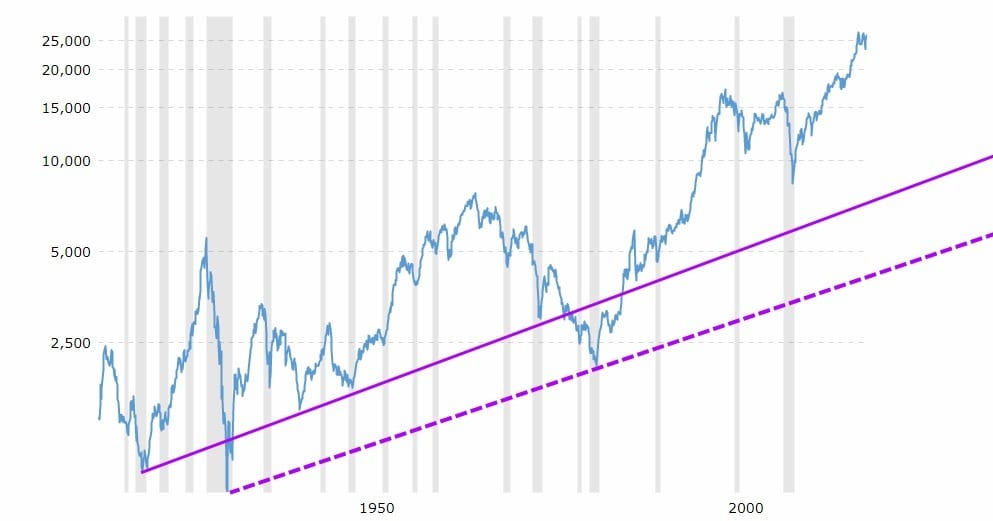Has the Stock Market Hit Rock Bottom?
May 15, 2025
Introduction
The market isn’t just moving — it’s bleeding. And yet, most investors still don’t feel the wound. They’ve been desensitised by the daily drip of CNBC doom and dopamine—high—frequency panic, low-frequency awareness.
A Brutal Decline — But Is It Over?
The S&P 500 hasn’t just slipped — it’s cratered over 17% from its highs this year, deeper than most headlines dare admit. The Nasdaq? Down a staggering 28%, tech darlings face a reckoning they weren’t priced for. The crowd is beginning to wake up, but they’re still asking the wrong question: Is buying safe?
That question itself is a psychological tell. When the majority seeks comfort, we’re not at the bottom. We’re mid-fall, and praying.
This isn’t just a correction. It’s a belief dislocation event. The Fed is on a warpath, using interest rates like precision-guided missiles to vaporise inflation. But what it’s also vaporising — quietly, ruthlessly — is the crowd’s confidence in their own expectations. Growth stocks that were once priced for perfection are now priced for penance.
Vector Mass Psychology in Play
Data does not drive the market. It’s driven by beliefs reacting to pressure. Each trader, fund, and algorithm is a vector, not just moving in a direction but carrying weight, momentum, and emotion. Right now, those vectors are splintered and not aligned—confusion = volatility.
When you zoom out and track mass vector behaviour, you don’t just see a drop. You see the structural failure of conviction. Investors are no longer betting on growth — they’re just trying to escape further pain. That’s not bottoming. That’s unravelling.
The average investor is still clinging to narratives — the soft landing myth, the Fed pivot hope, the earnings resilience theory. But true bottoms aren’t built on theories. They’re forged in capitulation, silence, and disgust. We’re not quite there yet.
The Setup Beneath the Surface
Yes, economic signals are scrambled. Consumer sentiment is crashing. Housing is cooling. Yet the job market still flickers with life. This is a psychological paradox — pain on one end, denial on the other. And paradoxes never last.
If inflation eases while jobs hold, we could see stabilisation — but it won’t be clean. It’ll be choppy, backloaded, and full of bear traps. If the job market cracks, expect earnings to implode and the next leg down to strike without mercy.
This isn’t about timing the bottom. It’s about reading the battlefield.
The Market Bottom: A Game of Perception
Bear markets don’t end when fear peaks—they end when most have given up. Historically, crashes overshoot, obliterating weak hands before reversing course. The key? Markets move ahead of reality—stocks could rebound before the economy does. Timing the exact bottom is a fool’s errand, but opportunity is brewing for those who see beyond the chaos.
The Tactical Investor approach? Ignore the noise, track sentiment, and watch for the real inflexion point—not when panic is loudest, but when exhaustion sets in. The battle isn’t over yet, but the time to prepare is now.
Fear Destroys Wealth, But Patience and Discipline Build It
In times of uncertainty, emotions run high, and panic-driven decisions wreak havoc on portfolios. The masses react to fear, selling at the worst possible moments, while seasoned investors recognise that chaos breeds opportunity. Markets are a battlefield where those who remain neutral, patient, and disciplined ultimately emerge victorious.
The current sharp correction (as of March 24th) has shattered confidence, yet history shows that downturns are the breeding ground for future gains. The impatient get shaken out, while those who maintain composure position themselves for the next surge. Timing the exact bottom is impossible, but understanding the psychology of market cycles gives you an edge.
Success in investing isn’t about reacting to every dip—it’s about controlling your emotions, recognizing when fear has peaked, and acting decisively when others hesitate. The question is: Will you let uncertainty dictate your moves, or will you master it and turn it into your advantage?
Cognitive Biases: How to Exploit Market Fear for Profit
Market selloffs aren’t just about fundamentals—they’re driven by psychology. When fear takes over, investors fall into predictable cognitive biases that fuel irrational decisions. Recognising these biases isn’t just insightful; it’s profitable.
- Loss Aversion – Investors feel the pain of losses far more than the joy of gains. This bias forces them to sell in panic, locking in losses instead of holding through recovery. Smart money exploits this by buying undervalued assets when fear is at its peak.
- Herd Mentality – The instinct to follow the crowd is strong when everyone is selling. But history proves that following the herd often leads to disaster. Contrarians step in when the masses flee, positioning for the inevitable rebound.
- Recency Bias – Investors assume the recent past will continue indefinitely. A falling market makes them believe it will never recover, just as a soaring market convinces them it will never drop. Recognising this bias helps in identifying turning points before the majority catches on.
- Confirmation Bias – People seek information that reinforces their fears. During a selloff, negative headlines dominate, fueling more panic. Successful traders filter out the noise and focus on data, not emotions.
- Anchoring Bias – Investors fixate on past highs, assuming stocks must return to those levels soon. Instead of reacting to new realities, they cling to outdated reference points, missing better opportunities in undervalued assets.
Markets don’t move purely on logic; they move on emotion. The winners are those who recognise these biases, detach from the herd, and act when others hesitate. The question isn’t whether fear will subside—it always does. The real question is: Will you capitalise on it or let it paralyse you?
Has the Stock Market Hit Bottom: Insights from The Tactical Investor
So far, we have examined the prevailing consensus, but our perspective on whether a market has hit bottom diverges significantly. In a nutshell, when a market experiences a significant correction or crash from a long-term standpoint, we see it as a buying opportunity. Allow the chart below to illustrate this perspective – sometimes, a chart speaks a million words.

This long-term chart effectively dispels any concerns about the narrative surrounding whether the market has reached a bottom or not. Any investor with the foresight to use firm corrections or so-called crashes to buy top stocks would have profited significantly, making out like “bandits.” Therefore, the primary focus should be building a portfolio of high-quality stocks before market pullbacks occur. This way, when they do, you’ll be well-prepared to act and potentially seize opportunities like a savvy “bandit” of the financial world.
Lost Opportunities in Market Crashes: A Contrarian’s Edge in 2025
Market crashes aren’t rare events—they’re rituals. Bloodlettings. And every time, the crowd reacts like it’s the first time the gods demanded sacrifice.
The myth of the “perfect crash entry” is a siren song for the uninitiated. They wait for an all-clear that never comes. In their paralysis, the real money flows elsewhere—quietly, strategically, into the hands of those who move before the collective regains its voice.
The crowd fled risk as rates soared, inflation raged, and the media choreographed another fear symphony. But that’s the setup. When pessimism saturates the air, value gets mispriced. The S&P 500 may look weak, but underneath the surface, pressure is shifting. Key technical levels held. Volume surged in select sectors. The weak hands panicked. The informed repositioned.
Smart money doesn’t chase headlines—it exploits them. And right now, it’s not retreating. It’s building positions in silence.
Vector Thinking in a Crowd-Control Market
If you’re still thinking linearly—buy low, sell high—you’ve already lost. Markets aren’t lines; they’re multi-dimensional psychological battlefields. Every signal has a counter-signal. Every trend has a shadow. This isn’t about spotting bottoms. It’s about decoding the belief systems of the herd and getting in before they switch polarity.
When belief collapses, a vacuum forms—and those with mental clarity move fast to fill it. That’s the contrarian edge: moving not against the crowd, but ahead of their next belief flip. You don’t need to be right. You need to be less wrong, faster.
Crashes create these moments—windows where belief inertia breaks. In that disarray lies asymmetric opportunity. Not for the timid. For the tactician.
Mastering Market Cycles: The Psychology of Fear and Opportunity
Every cycle is a story we’ve heard before. Accumulation. Markup. Distribution. Markdown. But the twist is always psychological. People don’t lose money because of the cycle. They lose because they misread where they are in the cycle.
We’re in the fog-of-war phase, where the media screams, “Recession!” and the VIX trembles but doesn’t spike. That’s your signal. When fear is ambient but not absolute, when despair hums but doesn’t crescendo, you’re not in the aftermath—you’re in the setup.
Inflation is bending. The Fed is nearing exhaustion. AI is re-architecting productivity. Liquidity is rotating, not evaporating. And the institutions? They’re sniffing for blood in beaten-down growth, financials, and tech—all while retail hangs back, praying for confirmation that never arrives.
This isn’t the time to mirror the crowd’s anxiety. It’s time to dissect, track, and capitalise on its future regret.
Lead the Cycle or Be Devoured by It
Mass psychology isn’t an indicator. It’s the engine. And it doesn’t wait. Bottoms happen in silence. They never ring a bell. They show up in weird volume, erratic breadth, and price action that punishes both bulls and bears before revealing their hand.
Wait for clarity, and the door slams shut.
You’re either leading the vector, or you’re being dragged by it.
Delectable Articles for the Inquisitive Reader.











